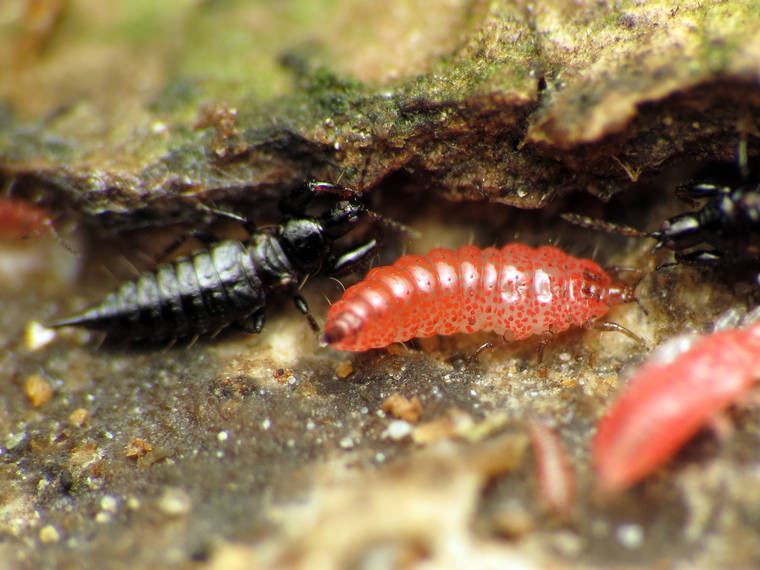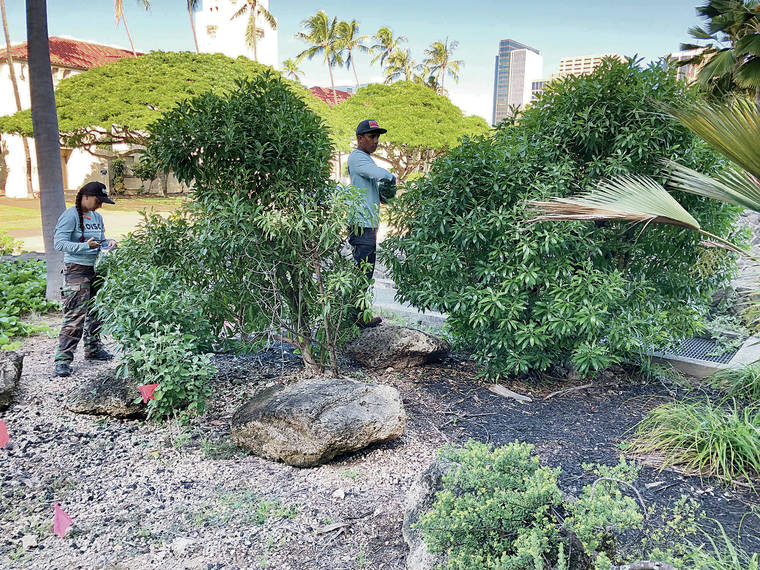Worried that an invasive insect will ravage Oahu’s native naio population as it did on Hawaii island, state officials are now urging people to remove healthy naio trees from their gardens before they become infected.
Less than a year after the tiny thrips were discovered here, officials say pesticide treatments have failed to stop the invasion, and they’re fearful the tiny marauders will spread to some of the island’s most important wild refuges.
“What we would want to do is protect our wild naio populations at Kaena Point, the Kaiwi Coast shoreline, Kalaeloa National Wildlife Refuge and the offshore islands,” said Erin Bishop, outreach specialist with the Oahu Invasive Species Committee. “The landscaped naio are a jumping-off point for these insects to spread across the island.”
Also known as false sandalwood, naio is considered an important part of the dry low- to mid-elevation forest in Hawaii, providing habitat for elepaio and endangered yellow- faced bees. On the coast, shearwaters and albatrosses use the tree for shelter.
But the tiny Myoporum thrip has devastated naio forests on the Big Island for about a decade and is now spreading across Oahu following its discovery here in November.
Dark brown to black, narrow and less than a tenth of an inch in size, the little bug has been found across the island’s southern coasts, from Diamond Head to Kapolei.
Bishop said the thrips have been spreading rapidly by hitchhiking on people and their clothing and traveling in the wind.
Bad news
The bad news is that pesticide treatments have been found to be ineffective in removing the bugs from landscaped areas, she said, and there are no effective pesticides for treatment in natural areas.
The good news is they haven’t been seen in any natural refuges or wildlife sanctuaries.
“They’re not there yet,” Bishop said. “We’re going to keep trying to stop them. We’re not giving up.”
Bishop said Thursday that crews have removed 1,049 plants on both public and private properties.
Native to Tasmania, the thrip probably came to the U.S. accidentally by being introduced in California. Officials think it found its way to the Big Island in 2009 via landscaping materials.
Thrips attack naio by sucking tissue out of new leaves. With no known natural predators, they thrive and feed on the plants so heavily that they stop producing new leaves and eventually die.
On Hawaii Island, recent surveys were unable to find even 10 healthy trees in the Puu Waawaa forest, and one Big Island conservationist compared their destructive ability to wildfire.
“It’s pretty sad,” Bishop said. “They had a nice wildland population in the forest reserve, but they were lucky to find 10 trees there. And even those were not doing well.”
2 counties unaffected
The thrips haven’t been seen on the islands of Kauai or Maui counties yet.
On Oahu the bugs recently were discovered in the native garden at the state Kalanimoku Building, headquarters of the state Department of Land and Natural Resources. They were removed by Oahu Invasive Species Committee crew members who clipped off the infested ends, removed entire plants and transported them to HPOWER to be burned.
A few months ago thrips were discovered infesting an 18-year-old naio shrub in the yard of Suzanne Case, DLNR chairwoman. Her naio tree was removed.
Officials say naio is easy to grow, has fragrant flowers and has been a popular landscape tree in Hawaii.
But no one should be planting it now, Bishop said, and anyone with a healthy naio in their yard should have it removed.
“It’s up to the homeowners. We can’t make them do anything,” she said.
Report damaged plants immediately to the Oahu Invasive Species Committee for removal and safe disposal. She said the agency will help those with naio replace their plants.
“OISC can provide aalii or hao as a replacement if you have infected naio,” she said.
Report invasive species sightings to the 643-PEST telephone hotline, the 643pest.org Opens in a new tab website or through the 643-PEST mobile app.




